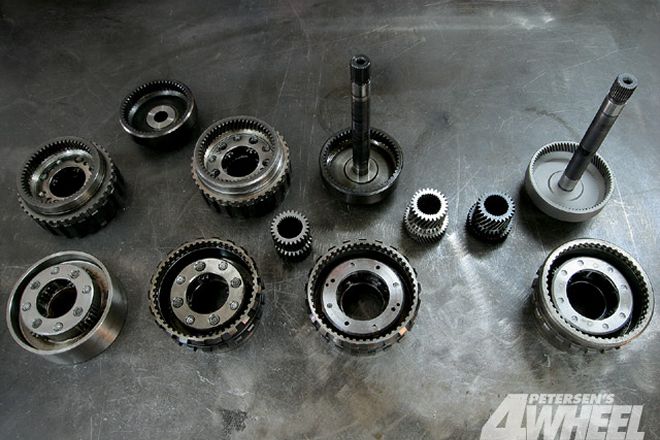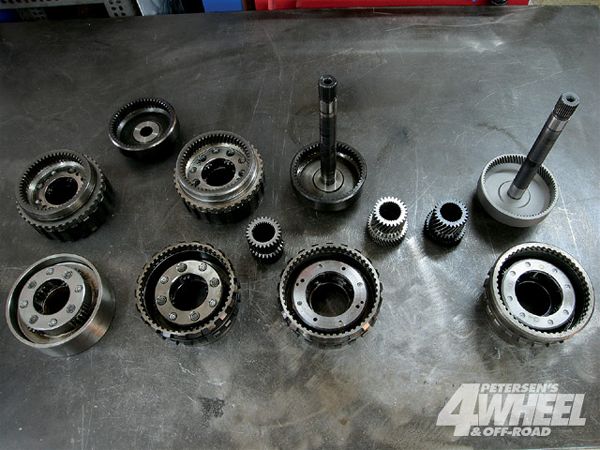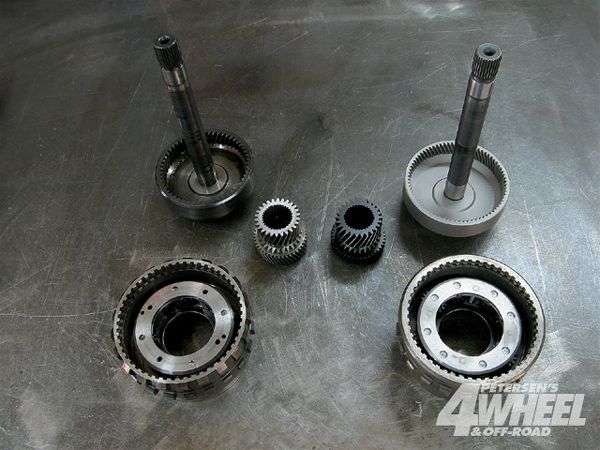
 What's the best TH400 gearset for towing? Four-planetary straight-cut, four-planetary helical, five-planetary helical, eight-planetary helical, 2.48:1, 2.75:1, 3.00:1.
What's the best TH400 gearset for towing? Four-planetary straight-cut, four-planetary helical, five-planetary helical, eight-planetary helical, 2.48:1, 2.75:1, 3.00:1.
New diesel pickups are ideal for towing trail toys and homes-away-from-home, but their prices of admission currently cause many to collect dust on dealers' lots. That's why fixing up old trucks is more popular now than ever.
Towing of any sort eventually takes its toll on the tug vehicle. A truck rebuild offers an opportunity for an upgrade, whether it's on the engine, transmission, transfer case, or axles. Here we'll examine how to make the well-respected Turbo 400 automatic even more tow-worthy using select aftermarket parts. The average four-wheeler might not be up to dissecting his or her TH400 juicebox, so we'll discuss some of the available upgrades instead of showing assembly highlights.
Unfortunately, there isn't a magic formula for determining the optimal Turbo 400 combination. According to automatic specialist Craig Calkins of CRC Performance Transmissions, building a tow-happy Turbo 400 needs to take all of these variables into account:
Engine Output
* 2WD or 4x4?
* Towing weight/GCWR
* Percentage of drive time spent towing
* Tire size
* Axle gearing
* Other aftermarket equipment such as aftermarket transfer-case gears/Doubler or auxiliary overdrive
* Is the truck also used for wheeling?
* Is it a freeway cruiser when not towing?
* Do the routes include steep grades and/or high altitudes?
* Is fuel economy a priority?
The underlying goal is to maximize efficiency-keep the engine within its powerband while towing a load. Calkins gives ballpark 60-mph rev ranges of 2,400-2,500 rpm for healthy GM small-blocks and 2,200-2,300 for big-blocks. (He adds that a 502 big-block can actually get better fuel economy than a 454-less gas is required to get the necessary off-the-line towing torque.) In general, the Turbo 400 can be built to handle as much as 500 hp and tow up to 13,000-pound trailers-although not necessarily daily. If you exceed these numbers regularly, refer to the "Swaps" section below.
Main Upgradeable Areas
Case: Two cases were available. 4x4 models have the "HD" case (stamped on the housing) with a cast-aluminum flywheel cover. Car applications got the "K"-stamped case and a plastic or sheet-steel cover. If you're sourcing a junkyard core, make sure it's an (uncracked) HD model.
Planetary Gearsets: Although the Turbo 400 is heavy-duty in stock form, its Achilles heel for towing is a "high" 2.48:1 First gear ratio. (The lighter-duty Turbo 350 has a more-desirable 2.52 First, and most later-model Overdrive automatics have 3.00 or lower Firsts.)
 The factory 2.48:1 First gearset with four-gear planetaries is on the left. Kilgore's 2.75:1 First (right) includes a sun gear, a drum, a shaft, and eight-gear planetaries. Kilgore's gears are made from harder-than-OE A-620 steel.
The factory 2.48:1 First gearset with four-gear planetaries is on the left. Kilgore's 2.75:1 First (right) includes a sun gear, a drum, a shaft, and eight-gear planetaries. Kilgore's gears are made from harder-than-OE A-620 steel.
Luckily, nonstock gear ratios are available for the TH400. John Kilgore-who has modified Turbo 400s since 1969 and has probably forgotten more about this transmission than many of the people who designed and assembled it ever knew-offers a variety of First gearsets. Marketed mainly to drag racers, Kilgore's available ratios range from 1.80:1 to 3.0:1. Lower-than-stock (numerically higher) gearsets place less off-the-line stress on the powertrain, providing better acceleration under lighter throttle.
Lower isn't always better, though. CRC's Calkins says that the 3.00 First is too low for many 4x4s, especially sand-runners-too much off-idle wheelspeed tends to dig down in the soft stuff. However, Chevy owners who also trail-ride with their tow rigs might consider the 3.00 First. Another option is choosing a higher First gear for better on-road towing economy and adding lower transfer-case gears, a Doubler, or an auxiliary overdrive unit for lower off-road gear reduction.
Depending on tire size, Calkins also feels that Kilgore's 2.75 First can also be too low for 4.56 axle gears, causing the engine to rev out of its powerband too quickly. However, a 2.75 First could be an ideal towing setup for trucks that run 35s with 4.10 axle gears. Calkins' personal big-block-powered K2500 runs a Kilgore 2.75 First-gear Turbo 400 with 4.56 axle gears and 37s to tow a 13,000-pound fifth-wheel on weekends. (His driveshaft angles rule out an auxiliary overdrive such as a Gear Vendors.)
Tight-budget enthusiasts have some junkyard swap/upgrade gearset options. Although the factory First gear ratio is always 2.48:1, medium-duty GM vehicles offered stronger carrier assemblies and sun gears than the light-duty applications: Older Turbo 400s found in cab/chassis packages, motorhome platforms, box vans, buses, and 1 1/2-ton trucks had four-pinion carriers with straight-cut gears. This is stronger than the helical-cut four-pinion carriers/sun gears in light-duty pickups and SUVs, but the straight gears are annoyingly noisy to some ears. A better OE setup is a five-pinion gearset out of the later heavier-application Turbo 400s and early 4L80s.
For even greater strength, Kilgore's aftermarket gearsets are made with eight-pinion planetary assemblies. More teeth allow the torque load to be disbursed over greater total gear-contact area.
Clutch Packs: CRC's Calkins says that proper assembly is key. Most name-brand "heavy-duty" kits (e.g., Raybestos) work fine for serious towing.
Shift Kits: CRC uses TransGo and other well-known kits, generally following their instructions for towing. CRC also does custom valving for unique needs.
Pan: Heat is the trans-killer. So, a larger pan with increased oil capacity is optimal. Later TH400s offered deeper pans; retrofitting requires also using the later-style pickup adapter. Aftermarket cast-aluminum pans offer extra capacity and improved heat-dissipation, but they can be pricey. Calkins advises avoiding cheap overseas pans, which tend to have sealing problems.
Torque Converter: Big and low are the way to go. Calkins builds Turbo 400s that tow with an aftermarket 13-inch Allison-application converter, having a 1,100- to 1,200-stall speed for better take-off when towing. (Higher stall speeds are recommended for extreme towing.) These converters feature reinforced hub areas.
Cooling: Calkins says that Turbo 400 cooling issues often originate in the radiator. After you verify that the trans-cooling lines are actually routed there, then fixing the existing radiator or, ideally, upgrading to a larger one can solve the problem. Coming out of the radiator, the ATF should go through the largest auxiliary cooler that'll fit in the vehicle. If the auxiliary cooler doesn't get good airflow, consider using an aftermarket unit that has its own electric fan.
Swaps: Depending on all the other variables, a properly set up, conservatively driven Turbo 400 can survive 400-500 hp engine power, 4.56 axle gears, and 37s while towing 12,000-13,000 pounds. Chevy/GMC owners who tax these limits regularly should consider upgrading to a more modern automatic. The 4L80E offers comparable strength and an overdrive Fourth gear (although Calkins cautions that towing heavy loads often requires higher revs than overdrive offers). Advance Adapters is one company that offers a controller to retrofit the computerized 4L80E into older vehicles.
An even stouter option is swapping in an Allison automatic rated at 620 lb-ft. DeStroked makes a standalone controller and adapters to swap the Allison into many nonstock applications. If towing requires an Allison, though, it might be cheaper and faster to trade in the old truck for a diesel rig. (Jim Bigley of The Diesel Page, www.thedieselpage.com, sells a swap manual that details how to retrofit a Duramax/Allison combo into older trucks.)
So, each totally-built-to-tow Turbo 400 prescription varies by vehicle and use. Good transmission shops should be able to recommend the best combination for the towing task at hand.
Turbo 400 Trivia
Most four-wheelers respect the TH400 for its strength. Its only knocks are the long housing (which is still shorter than the newer OD automatics) and the lack of a fourth (Overdrive) gear.
This beloved automatic made its first mass-production appearance in '64 Cadillacs and Buicks as the Super Turbine 400. It eventually handled gear reduction in large GM passenger cars, 3/4- and 1-ton trucks, medium-duty trucks, cab/chassis vehicles (including many motorhome coaches), step vans, and buses. Many higher-end British cars and even Ferraris have had the Turbo 400.
In 1987 GM's Turbo-Hydramatic division dumped the cable-operated speedometer for an electric one and renamed the transmission the 3L80 (trucks received the 3L80HD designation to indicate the stronger case and deeper pan); all other Turbo 400 components remained the same. By 1992 the Turbo 400 had been replaced in all passenger and light-duty-truck applications with four-speed overdrive automatics. However, the Turbo 400 continued to be produced for military Humvees.






 "HEAVY" LIGHT-DUTY GM AUTOMATIC TRANSMISSION GEAR RATIOS Model 1st 2nd 3rd 4th 5th 6th Rev. TH400 2.48 1.48 1.00 - - - 2.07 4L80E 2.48 1.48 1.00 0.75 - - 2.07 Allison 1000 3.10 1.81 1.41 1.00 0.71 0.61 4.49 Allison 2000 3.51 1.{{{90}}} 1.44 1.00 0.74 - 5.09
"HEAVY" LIGHT-DUTY GM AUTOMATIC TRANSMISSION GEAR RATIOS Model 1st 2nd 3rd 4th 5th 6th Rev. TH400 2.48 1.48 1.00 - - - 2.07 4L80E 2.48 1.48 1.00 0.75 - - 2.07 Allison 1000 3.10 1.81 1.41 1.00 0.71 0.61 4.49 Allison 2000 3.51 1.{{{90}}} 1.44 1.00 0.74 - 5.09 
